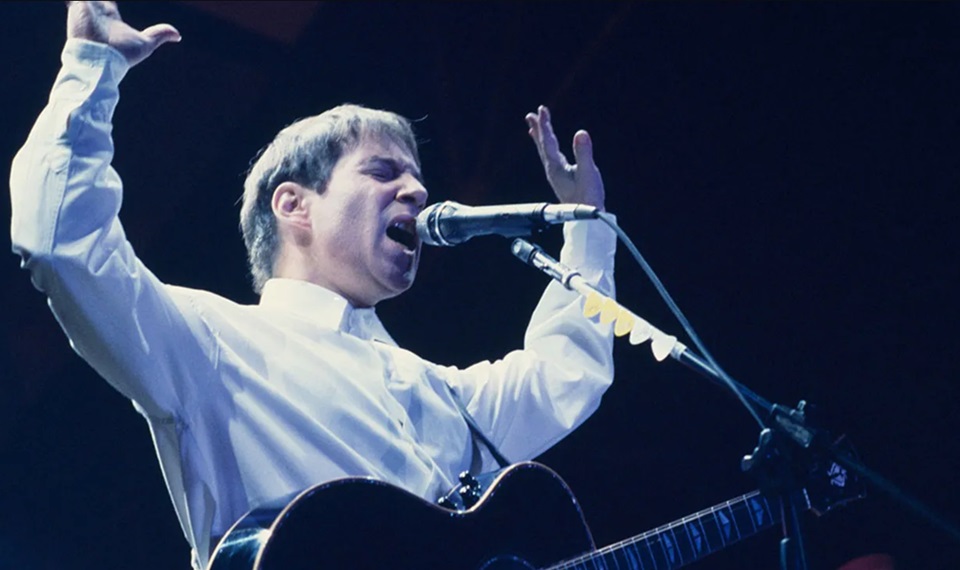
TORONTO—Some important film releases about music celebrities premiered at the Toronto International Film Festival, and they all have a connection to progressive struggle.
The long career of singer/guitarist Paul Simon was so packed that a new film about his life is divided into two parts: the first half with Art Garfunkel and the second half solo. The 3½ hour masterful epic, In Restless Dreams: The Music of Paul Simon, is the latest work of prolific documentarist Alex Gibney (The Trials of Henry Kissinger, Taxi to the Dark Side) covering Paul’s career and personal life from his first days with Art in high school (they were called Tom & Jerry) to his most recent album production, Seven Psalms. Through his fascinating career, Simon (and Garfunkel) usually chose not to be part of political events, to avoid alienating parts of their huge fan base. However, many of his songs have social content, and at least two main projects stand out.
In 1987, Simon produced his most successful studio album, the award-winning Graceland, which featured artists from South Africa, including Ladysmith Black Mambazo and Youssou N’Dour. It was recorded while the country was still under apartheid. Although the work helped promote these amazing performers and helped end apartheid, Simon was banned by the UN and the African National Congress for going to South Africa and breaking the cultural boycott. He was later exonerated, but for a time it had a negative impact on his career.
In 1997, he produced his last theater project on Broadway, followed by an album of him singing all the songs. The groundbreaking Puerto Rican-influenced Songs from The Capeman was a departure from his usual style, which included doo-wop, rock ‘n’ roll, and Latin music. Unfortunately, it was a commercial flop but had a lot to say about race and politics in America. Throughout his long career, several of his hits referenced social issues, including titles such as “Bridge Over Troubled Water,” “Peace Like a River,” “Homeless,” and “American Tune,” which became an anthem for the failed promises of America. Gibney’s doc about Simon, though lengthy, is totally absorbing to the end, and another masterpiece from the seasoned filmmaker.

It’s hard to imagine that you could find a more spellbinding animated Latin musical than Chico and Rita, (full movie on YouTube), which brought to life the excitement of musicians in pre-Fidel Havana. But the same team of Spanish writer/director/producer Fernando Trueba and Javier Mariscal upped themselves by creating yet another stunning animated film, They Shot the Piano Player, about yet another Latin pianist—but this one was real. The mostly overlooked young Brazilian pianist, Francisco Tenório Júnior, played and recorded with most of the star performers during the popular Bossa Nova craze starting around 1959.
He disappeared mysteriously from the music scene in 1976 and was found later to have been assassinated in Argentina during the military coup. Trueba structures the animated docudrama around a music journalist (voiced by Jeff Goldblum) investigating the pianist’s disappearance by interviewing famous performers (all done in animation!), including luminaries Milton Nascimento (“Bridges”), Gilberto Gil, Bud Shank, Bebo Valdés, Antônio Carlos Jobim and many other notable Latin legends. Several spoke about the role of U.S. imperialism in Latin America. Trueba felt that one of the main reasons the bossa nova craze died down was because of the U.S. government’s foreign policy that funded coups in Brazil and Argentina which caused many deaths and started an era of totalitarianism in Latin America which lasted for several decades.
The film is loaded with classic Brazilian music, including references to the Oscar-winning musical Black Orpheus and the iconic music that came from it. The directors interviewed over 150 people throughout the many years it took to complete this impressive work of Latin art and music history. The young pianist, Tenório, was described as a most sensitive player influenced by pianists like Bill Evans. Although he didn’t belong to any political organizations, he was known to be sympathetic to communism and was probably killed for it.
This is yet another example of artists having to choose between being an active party member or trying to make a living as an artist. It’s often difficult to do both, as we’ve learned from such notable performers like Pete Seeger and Paul Robeson, to name just two.
One movie that I didn’t get to see but received rave reviews, is Maestro, the biopic about the great American composer/conductor, Leonard Bernstein, who was gay and Jewish and progressive as well. Many of his works address social themes, and he was on Joseph McCarthy’s and J. Edgar Hoover’s “Dared to Question Capitalism” lists—especially after he stunned society by hosting a private gathering in his toney Upper West Side apartment to raise support for the Black Panthers (not dealt with in the film). One of America’s greatest music personalities certainly deserved a film treatment like Maestro.
Another musical artist that’s not often thought of in political terms is the famed clarinetist/bandleader Artie Shaw. He was one of the first bandleaders to break the color barrier by hiring the legendary Billie Holiday,
Back in 1985, Toronto filmmaker Brigitte Berman received an Academy Award for Best Documentary Feature for Artie Shaw: Time Is All You Got. It’s been digitally restored and featured at this year’s Festival. Shaw grew up poor in New York City with a Russian Jewish heritage. His life and musical career are reviewed in this important re-release.
He was a complex intellectual and musician, who was also on Joseph McCarthy’s blacklist because he had been a member of the Communist Party and at one time defended the Soviet Union against Richard Nixon, which must have been an interesting discussion. Shaw praised artistry and was offended by commercialism in the arts. His theme song, “Nightmare,” is totally opposite to most big bands’ commercially appealing swing dance style. To everyone’s surprise, Shaw instantly quit the music business in 1954 and never played publicly again.
Canada’s POV magazine gave a positive review of the restored version: “The film remains a brilliant portrait of a difficult man, an artist who was never happy with himself or anyone else. But thanks to Brigitte Berman, his life has been successfully captured on film—and digitally—for generations to come.”
We hope you appreciated this article. At People’s World, we believe news and information should be free and accessible to all, but we need your help. Our journalism is free of corporate influence and paywalls because we are totally reader-supported. Only you, our readers and supporters, make this possible. If you enjoy reading People’s World and the stories we bring you, please support our work by donating or becoming a monthly sustainer today. Thank you!










